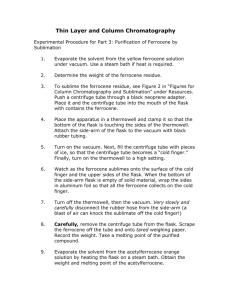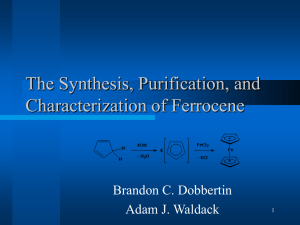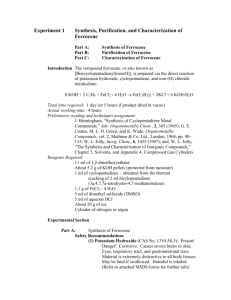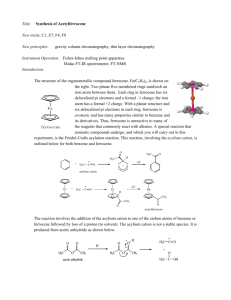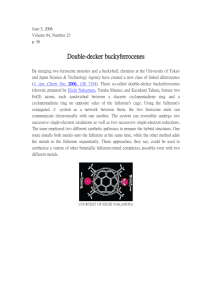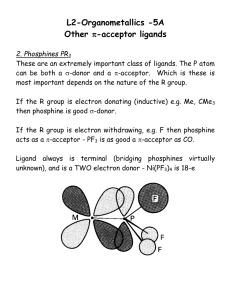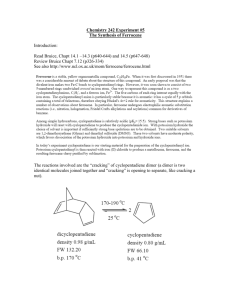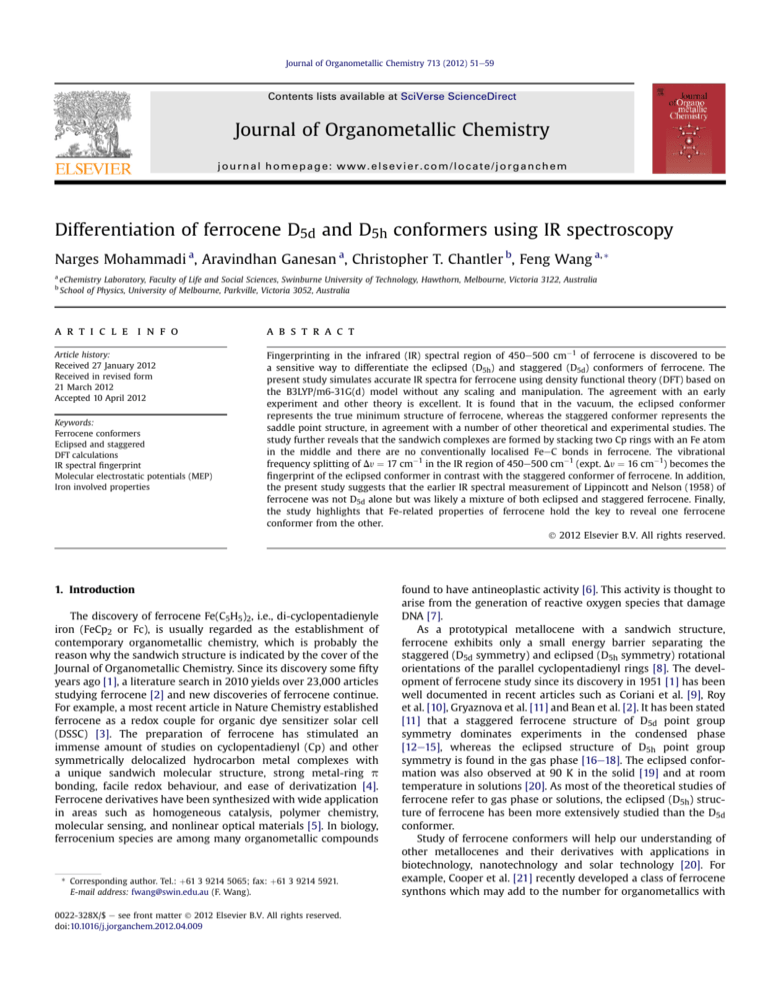
Journal of Organometallic Chemistry 713 (2012) 51e59
Contents lists available at SciVerse ScienceDirect
Journal of Organometallic Chemistry
journal homepage: www.elsevier.com/locate/jorganchem
Differentiation of ferrocene D5d and D5h conformers using IR spectroscopy
Narges Mohammadi a, Aravindhan Ganesan a, Christopher T. Chantler b, Feng Wang a, *
a
b
eChemistry Laboratory, Faculty of Life and Social Sciences, Swinburne University of Technology, Hawthorn, Melbourne, Victoria 3122, Australia
School of Physics, University of Melbourne, Parkville, Victoria 3052, Australia
a r t i c l e i n f o
a b s t r a c t
Article history:
Received 27 January 2012
Received in revised form
21 March 2012
Accepted 10 April 2012
Fingerprinting in the infrared (IR) spectral region of 450e500 cm1 of ferrocene is discovered to be
a sensitive way to differentiate the eclipsed (D5h) and staggered (D5d) conformers of ferrocene. The
present study simulates accurate IR spectra for ferrocene using density functional theory (DFT) based on
the B3LYP/m6-31G(d) model without any scaling and manipulation. The agreement with an early
experiment and other theory is excellent. It is found that in the vacuum, the eclipsed conformer
represents the true minimum structure of ferrocene, whereas the staggered conformer represents the
saddle point structure, in agreement with a number of other theoretical and experimental studies. The
study further reveals that the sandwich complexes are formed by stacking two Cp rings with an Fe atom
in the middle and there are no conventionally localised FeeC bonds in ferrocene. The vibrational
frequency splitting of Dy ¼ 17 cm1 in the IR region of 450e500 cm1 (expt. Dy ¼ 16 cm1) becomes the
fingerprint of the eclipsed conformer in contrast with the staggered conformer of ferrocene. In addition,
the present study suggests that the earlier IR spectral measurement of Lippincott and Nelson (1958) of
ferrocene was not D5d alone but was likely a mixture of both eclipsed and staggered ferrocene. Finally,
the study highlights that Fe-related properties of ferrocene hold the key to reveal one ferrocene
conformer from the other.
Ó 2012 Elsevier B.V. All rights reserved.
Keywords:
Ferrocene conformers
Eclipsed and staggered
DFT calculations
IR spectral fingerprint
Molecular electrostatic potentials (MEP)
Iron involved properties
1. Introduction
The discovery of ferrocene Fe(C5H5)2, i.e., di-cyclopentadienyle
iron (FeCp2 or Fc), is usually regarded as the establishment of
contemporary organometallic chemistry, which is probably the
reason why the sandwich structure is indicated by the cover of the
Journal of Organometallic Chemistry. Since its discovery some fifty
years ago [1], a literature search in 2010 yields over 23,000 articles
studying ferrocene [2] and new discoveries of ferrocene continue.
For example, a most recent article in Nature Chemistry established
ferrocene as a redox couple for organic dye sensitizer solar cell
(DSSC) [3]. The preparation of ferrocene has stimulated an
immense amount of studies on cyclopentadienyl (Cp) and other
symmetrically delocalized hydrocarbon metal complexes with
a unique sandwich molecular structure, strong metal-ring p
bonding, facile redox behaviour, and ease of derivatization [4].
Ferrocene derivatives have been synthesized with wide application
in areas such as homogeneous catalysis, polymer chemistry,
molecular sensing, and nonlinear optical materials [5]. In biology,
ferrocenium species are among many organometallic compounds
* Corresponding author. Tel.: þ61 3 9214 5065; fax: þ61 3 9214 5921.
E-mail address: fwang@swin.edu.au (F. Wang).
0022-328X/$ e see front matter Ó 2012 Elsevier B.V. All rights reserved.
doi:10.1016/j.jorganchem.2012.04.009
found to have antineoplastic activity [6]. This activity is thought to
arise from the generation of reactive oxygen species that damage
DNA [7].
As a prototypical metallocene with a sandwich structure,
ferrocene exhibits only a small energy barrier separating the
staggered (D5d symmetry) and eclipsed (D5h symmetry) rotational
orientations of the parallel cyclopentadienyl rings [8]. The development of ferrocene study since its discovery in 1951 [1] has been
well documented in recent articles such as Coriani et al. [9], Roy
et al. [10], Gryaznova et al. [11] and Bean et al. [2]. It has been stated
[11] that a staggered ferrocene structure of D5d point group
symmetry dominates experiments in the condensed phase
[12e15], whereas the eclipsed structure of D5h point group
symmetry is found in the gas phase [16e18]. The eclipsed conformation was also observed at 90 K in the solid [19] and at room
temperature in solutions [20]. As most of the theoretical studies of
ferrocene refer to gas phase or solutions, the eclipsed (D5h) structure of ferrocene has been more extensively studied than the D5d
conformer.
Study of ferrocene conformers will help our understanding of
other metallocenes and their derivatives with applications in
biotechnology, nanotechnology and solar technology [20]. For
example, Cooper et al. [21] recently developed a class of ferrocene
synthons which may add to the number for organometallics with
52
N. Mohammadi et al. / Journal of Organometallic Chemistry 713 (2012) 51e59
useful medicinal properties [22]. The rotational energy barriers
with respect to the metalecyclopentadienyl axis between the
eclipsed and staggered conformers are very low [20,23], as a result,
it is possible that the ground electron state structures of ferrocene
may contain both of the conformations. The fact that electronic
structures and properties of the ferrocene conformers are strikingly
similar is a key hurdle to differentiate or separate the configurations from one another. However, detailed studies of D5h and D5d of
ferrocene are important as ferrocene derivatives may inherit
particular properties which only exist in one conformer [23].
For example, additional ligands coordinating to the metal and
the Cp rings while maintaining certain symmetry, can be
a geometric requirement for the D5h conformer [21]. In addition,
the understanding of synthesis pathways, mechanics and reaction
dynamics of the ferrocene derivatives will require the understanding of the structure, symmetry and properties of the ferrocene
conformers.
Density functional theory has been revealed as cost effective and
accurate method to study electronic structures and properties of
ferrocene [9,11]. It begins to recognize that the CpFeCp structure
does not confine to the conventional FeeC “bonds” [2]. Infrared (IR)
spectra of ferrocene [11,24] reveal torsional or swing vibrations of
CpFeCp in the low energy region of <600 cm1, indicating that it is
unlikely that such ten localised FeeC bonds exist in the ferrocene
structures as proposed [9e11,24]. Rather, the most likely structures
for both D5h and D5d conformers of ferrocene can be structures of
stacking two pentagon Cp rings in two orientations. The stacking
structures are able to explain why the IR spectra could observe
CpFeCp swing vibrations in low energy IR regions [24]. Furthermore, Gryaznova et al. [11] revealed that the DFT simulated IR
spectra of ferrocene are reliable and can be employed to diagnose
the spin state (S ¼ 0) of the transition metal (Fe) complexes. The IR
spectra of CpFeCp have been measured in both vapour and solution
with reasonably good resolution in the region of 400e4000 cm1
over half a century ago [24]. As limited by accurate theoretical
support at the time of this early experiment, their analyses
assumed that the observed IR spectra belong to the D5d conformer
of ferrocene [24]. In fact the actual measured IR spectra indicated
the opposite, that is, the D5h (eclipsed) ferrocene conformer
domination in vapour state due to the observed spectral peak
splitting in the 450e500 cm1 region. The eclipsed structure for
ferrocene is in agreement with a microwave experiment [16]
several years later. In the present study, we use simulated IR
spectra and a number of other properties of D5h and D5d conformers
of ferrocene, combined with available experiments [16e18,24] and
other theoretical calculations [9e11] to confirm that the eclipsed
conformer dominates the ferrocene in the vapour phase.
2. Computational methods
All calculations are performed using the Gaussian 09 computational chemistry package [25]. Geometry optimizations of the
ferrocene conformers are carried out using the B3LYP/m6-31G(d)
model. The basis set m6-31G(d), a modified version of the 631G(d) [26], is employed in the calculations. This basis set incorporates necessary diffuse d-type functions for the first-row transition metals such as Fe. It exhibits a better performance than the
conventional 6-31G(d) basis set for the iron atom in ferrocene by
providing a more appropriate description for the important energy
difference between the atomic 3dn4s1 and 3dn14s2 states [27]. The
infrared (IR) spectra of the ferrocene conformers are simulated on
the optimized structure using the same model.
Fig. 1. Optimized molecular structures of the D5h (eclipsed) and D5d (staggered) conformers of ferrocene in three-dimensional (3D) space.
N. Mohammadi et al. / Journal of Organometallic Chemistry 713 (2012) 51e59
A potential energy scan (PES) is performed by rotating the
central cyclopentadienyl axis which is defined by a dihedral angle
d (C(1)X(2)Fe(3)eC(4)) which connects the centres of each cyclopentadienyl planes through the middle Fe atom. The PES produced
from the calculations starts from an eclipsed conformer (d ¼ 0 ) at
a step size of Dd ¼ 4 . Due to the pentagonal structure of the Cp ring,
every 36 that the dihedral angle rotates will result in an alternative
staggeredeeclipsed conformation periodically.
Table 1 compares selected characteristic geometric and electronic properties of D5h and D5d conformers of ferrocene with other
theoretical and experimental results. The ground electronic state of
ferrocene is a low-spin state as indicated by Gryaznova et al. [11],
our B3LYP/m6-31G(d) model gives the configurations as
00
The optimised geometries of the eclipsed and staggered
conformers of ferrocene are given in Fig. 1 as three-dimensional
(3D) structures. Our calculations indicate that the eclipsed
conformer is a true global minimum structure of ferrocene without
imaginary frequencies in isolation, whereas the staggered
conformer is the saddle point in the gas phase due to imaginary
frequencies. This is in good agreement with other theoretical
studies [9e11]. Although the graphic user interface (GUI) tools for
computational chemistry packages such as ADFView [28] and
Molden [29] almost always indicate the ten localised FeC bonds
existing in both D5h and D5d conformers of ferrocene in display, the
ferrocene orientations are likely to adopt stacking structures due to
the ligand p-orbitals and aromaticity as noted by Bean et al. [2].
Infrared (IR) discussion herein will also provide evidences of the
stacking structures rather than the conventional FeeC bonds for
ferrocene.
00
00
00
D5h, X1A2: (core).(e1)4(a10 )2(e10 )4(e20 )4(e2)4(a2)2(e1)4(e10 )4(a10 )2
00
(e20 )4(e1)0
D5d, X1A1g: (core).(e1g)4(a1g)2(e1u)4(e2u)4(e2g)4(a2u)2(e1g)4
(e1u)4(a1g)2(e2g)4(e1g)0
3. Results and discussion
3.1. Geometries and PES scan
53
The major difference between the conformers is due to
a symmetric plane for D5h but a symmetric centre for D5d in their
point group character tables. As a result, the orbital irreducible
representations which are correlated as 0 and 00 in D5h become g and
u in D5d. The highest occupied molecular orbital (HOMO) of D5h
conformer is a doubly degenerate e20 state and the next HOMO
(HOMO-1) is a10 but the lowest unoccupied molecular orbital
00
(LUMO) is e1 which agrees well with previous DFT based B3LYP/631G** calculations [2]. On the other hand, the HOMO for D5d is
a doubly degenerate e2g state, the HOMO-1 is a1g and LUMO is e1g.
Fig. 2 gives the orbitals of the doubly degenerate HOMOs for D5h
(e20 ) and for D5d (e2g), as well as the doubly degenerate LUMOs for
00
D5h (e1) and for D5d (e1g), based on our B3LYP/m6-31G(d) calculations. As can be seen in this figure, although the HOMOeLUMO
gaps of the eclipsed and the staggered exhibit a small difference
in energy (0.04 eV), the HOMOs and LUMOs of the eclipsed and
staggered exhibit major similarities to their corresponding partners, except the bottom Cp of the eclipsed ferrocene orbitals which
Table 1
Comparison of the optimized geometries of eclipsed and staggered ferrocene conformers.
Bond/angle
Eclipsed (D5h)
FeeC5 (Å)f
FeeC (Å)
CeC (Å)
CeH (Å)
;C5eH (Å)
Etotal(Eh)
Etotal þ ZPE(Eh)
<R2> (a.u)
m (Debye)
Electronic state
DHOMOeLUMO (eV)
A,B,C (GHz)
Staggered (D5d)
FeeC5 (Å)
FeeC (Å)
CeC (Å)
CeH (Å)
;C5eH (Å)
Etotal(Eh)
Etotal þ ZPE(Eh)
<R2> (a.u)
m (Debye)
Electronic state
DHOMOeLUMO (eV)
A,B,C (GHz)
a
b
c
d
e
f
g
h
B3LYPa
HFb
MP2c
CCSD(T)c
B3LYP/Type-Id
Expt.e
1.670
2.065
1.428
1.082
0.66
1650.662h
1650.492
1358.84
0.0
1 0
A1
5.30
A: 2.19453
B: 1.05862
C: 1.05862
1.865
2.219
1.413
1.074
0.58
1.464
1.910
1.441
1.076
0.33
1.655
2.056
1.433
1.077
1.03
1.687e1.688
2.079e2.080
1.428
1.660
2.064 0.003
1.440 0.002
1.104 0.006
3.7 0.9g
1.674
2.068
1.428
1.082
0.92
1650.661h
1650.491
1361.78
0.0
1
A1g
5.26
A: 2.19455
B: 1.05503
C: 1.05503
1.866
2.220
1.413
1.074
0.55
1.487
1.925
1.437
1.076
1.39
1.659
2.058
1.432
1.077
1.34
This work with the B3LYP/m6-31G(d) model. The basis set is a modified version of 6-31G(d) basis set [26].
See [34].
See [9].
See [11].
See [17].
Denotes the distance from Fe atom to the centre of cyclopentadienyl ring.
See [18]. From an ND experiment (not corrected for thermal motion) the value is 1.7 0.2 [35].
Energy difference between D5h,and D5d is: DE ¼ 0.0272 eV ¼ 0.62 kcal mol1 (0.9 kcal mol1, expt. [17]).
54
N. Mohammadi et al. / Journal of Organometallic Chemistry 713 (2012) 51e59
Fig. 2. The highest occupied molecular orbitals (HOMOs) and the lowest unoccupied molecular orbitals (LUMOs) of the eclipsed (D5h) and the staggered (D5d) conformers of
ferrocene.
are not mirror reflection of the top part as in the staggered. The
HOMOs and LUMOs are dominated by both the iron atom and the
carbon atoms of ferrocene. As a result, the differences between the
HOMOs and LUMOs are not significant enough to differentiate the
conformers.
Fig. 3(a) reports the potential energy scan (PES) of ferrocene
when rotating the central cyclopentadienyl axis, i.e., the dihedral
angle, d (;C(1)eX(2)eFe(3)eC(4)) where X(2) is a dummy atom
located at the centre of the top Cp pentagon plane as shown in
Fig. 3(b). As indicated before, due to the pentagonal structure of Cp
fragment, rotation of the dihedral angle d from 0 to 2p will
reproduce D5h and D5d five times periodically as the period is 2p/5.
The energy difference, DE, between D5h and D5d conformers of Fc is
given by 0.62 kcal mol1 using the B3LYP/m6-31G(d) model,
comparing to approximately 0.9(3) kcal mol1 as measured by gas
phase electron diffraction (GED) [17]. This result is in agreement
with other DFT calculations [9]. Due to their high symmetries, both
D5h and D5d conformers do not possess permanent dipole
moments. As a result, the IR spectroscopy of ferrocene will be due
to induced dipole moments during vibration. The calculated
molecule size (i.e., the electronic spatial extent <R2> as given in
Table 1) of the D5d conformer is slightly larger than the D5h
conformer. The former (D5d) is 1361.80 a.u. but the latter (D5h) is
1358.84 a.u. The size of D5d is slightly larger but was found in
condensed phase, whereas the smaller size ferrocene D5h is found
in gas phase, solid and solution. The energy gap between the HOMO
and the LUMO, i.e., Dε(HOMOeLUMO), is given by 5.30 eV and
5.26 eV for D5h and D5d, respectively. However, such small differences in the properties are not sufficient to warrant meaningful
investigation for such differences in most measurements. Other
properties which can differentiate the conformers sensitively ought
to be disclosed.
The optimized geometric parameters for the conformer pairs
are almost identical using the same model as shown in Table 1. For
example, all CC bonds are given by 1.428 Å and all CH bonds are
reported as 1.082 Å. The results in Table 1 also indicate that the
hydrogen atoms of Cp are not in the same plane with the C5
pentagon ring. The hydrogen atoms slightly bend towards their
counterpart in the opposite Cp ring, again in agreement with
experimental findings [18] that the conformer bend angle
N. Mohammadi et al. / Journal of Organometallic Chemistry 713 (2012) 51e59
55
The middle panels, (a2) and (b2) are the MEP cross-sections with
an oblique cut through the centre Fe atom. The MEP cross-sections
in (a2) and (b2) are very different for D5h and D5d, reflecting their
unique symmetries of sh for D5h and i for D5d. For example, staggered D5d gives a symmetric 2D MEP showing the character of the
symmetric centre, i, whereas the eclipsed D5h provides a butterfly
shaped 2D MEP exhibiting a single sh plane. Furthermore, the
bottom panels, (a3) and (b3) are cross-sections through the centre
Fe atom parallel to the Cp rings, which clearly indicate that the
electron densities at the Fe centre and its vicinity are very different
in D5h and D5d conformers. As shown in Fig. 4(a3), the electron
density map of the eclipsed Fc presents a pentagonal MEP, whereas
Fig. 4(b3) reports an electron disk centred at the Fe atom in the
staggered Fc. The observation suggests that any properties of
ferrocene reflecting such different sh and i symmetries may be able
to differentiate the conformers. This information provides a clue for
us to concentrate on the Fe-centred properties in the next sections.
3.3. Infrared (IR) spectroscopy of ferrocene
Fig. 3. (a) Potential energy scan (PES) of the dihedral angle rotating the axis connecting the middle Fe atom as well as the centres of two Cp rings. Due to the pentagon
structure of Cp, every 36 rotation of the dihedral angle will produce either the D5h or
the D5d structure once. This figure only presents a period of the PES. (b) The definition
of the dihedral angle.
involving the hydrogen atoms in D5h is ;C5H ¼ 3.7 0.9 .
However, calculations indicated that this angle is much smaller
than the crystalline structure of D5h of Fc, from ;C5H ¼ 0.66 in
B3LYP/m6-31(d) to ;C5H ¼ 1.03 in CCSD(T)/TZV2Pþf [9]. Theory
also indicates that this angle, ;C5H, for D5d (0.92 in B3LYP/m631(d) and 1.344 in CCSD(T)/6-31G** [9]) is larger than that of D5h.
Small differences of the distances between Fe and the Cp rings in
D5h and D5d are also observed. The FeCp distance of the latter
(D5d) is slightly longer than the FeCp distance in D5h, i.e., 1.674 Å
in D5d whereas in D5h this distance is given by 1.670 Å.
3.2. Molecular electrostatic potential
Cross-sections of the molecular electrostatic potentials (MEPs)
of D5h and D5d conformers are given in Fig. 4. The upper panels,
(a1) and (b1), are the cross-sections through one of the pentagon
Cp rings of the conformers, which are virtually identical in D5h
and D5d as only one of the Cp rings is presented in the MEP which
is independent of the other Cp ring and their orientation. Perhaps
the noticeable difference between (a1) and (b1) is that the
projection of the opposite Cp ring overlaps with the working Cp
ring in D5h, whereas the same projection in the D5d case does not
overlap with the working Cp ring due to its reflection centre, i.
Fig. 5 compares the simulated infrared spectra of D5h and D5d of
ferrocene in the region of 400e4000 cm1 using our B3LYP/m631G(d) model. The spectrum in red is for D5d but black for D5h.
There is not any scaling or manipulation in the present calculations.
The IR spectra of ferrocene are relatively simple with only a few
transition peaks (I s 0) caused by vibrations which lead to induced
dipole moments due to the absence of permanent dipole moments
in ferrocene. The spectra consist of six major peaks, in excellent
agreement with the simulated IR spectra (S ¼ 0) using the B3LYP/
Type-I model from Ref [11]. The IR spectra are very similar in D5h
and D5d with only small blue shift in the spectra of the eclipsed
(D5h) ferrocene. For example, the clustered IR peaks of the eclipsed
D5h conformer in the region <500 cm1 (highlighted in a dotted
box) show a small blue shift of ca. 12 cm1. The simulated IR spectra
agree well with the major peaks in the experimentally measured IR
spectra of ferrocene in vapour [24], except that the entire IR band in
the region of 1600e1750 cm1 shown in this earlier experiment is
missing in theoretical results including the present study and
a previous one [11]. It suggests that this medium strong IR band in
the experiment [24] might be stemmed by vibrations other than
ferrocene, such as impurities and the environment etc.
To further understand the IR spectra of Fc, more detailed analysis is needed. Table 2 reports the IR spectral analysis in the region
of 400e4000 cm1 for the six major non-zero intensity (I s 0)
transitions in Fig. 5. In this table, the IR frequencies of conformer
D5h compare with a recent theoretical study of the same conformer
of Fc (D5h) [11] and an earlier experimental study (D5d) of Lippincott
and Nelson [24]. The agreement between the present results and
recent theoretical results (only for the D5h conformer) [11] is good.
However, it is noted that in Ref. [11] the Type-I basis set in the
B3LYP/Type-I model uses the 6-31G* basis set for the ligand atoms,
such as H and C, but the ECP LanL2DZ basis set for the Fe atom. The
calculated IR frequencies of eclipsed ferrocene have been scaled by
a number of scaling factors (see Table 1S in the supplementary
materials in Ref. [11]). For example, the calculated FeC stretching
vibrations need a scale factor as large as 1.25 in order to fit the
corresponding experimental vibrational frequencies of Lippincott
and Nelson [24], whereas one of the scale factors for the CH
stretch vibrations is given as 0.889 [11].
In the present study, the IR frequencies for both D5h and D5d
conformers of ferrocene using the B3LYP/m6-31G(d) model are the
direct results without any scaling and manipulation. Because the
modified m6-31G(d) basis set [26], which incorporates necessary
diffuse d-type functions for the first-row transition metals such
as Fe, exhibits a more accurate performance than the ECP
56
N. Mohammadi et al. / Journal of Organometallic Chemistry 713 (2012) 51e59
LanL2DZ basis set (Type-I) for the iron atom in ferrocene, the m631G(d) basis set provides a more appropriate description for the
important energy difference between the atomic 3dn4s1 and
3dn14s2 states [26,27]. As a result, the present IR frequencies in the
region of 400e4000 cm1 agree well with experiment without any
scaling.
Based on point group theory, there are eight irreducible representations (modes) for each of the D5h and D5d [24] ferrocene
conformers. According to the selection rules, five of the modes are
IR active modes but three of them are IR inactive. Among the five IR
active modes, only two modes will show strong IR transitions, as
indicated by their character table. That is,
00
00
00
00
D5h: a10, a20 , e10, e20 , a1, a2, e1, and e2;
00
00
00
IR active: a10, e10, e20 , a2, e1; where e10 and a2 are strong IR
active modes;
00
00
IR inactive: a1, a20 , and e2;
D5d: a1g, a2g, e1g, e2g, a1u, a2u, e1u, e2u;
IR active: a1g, e1g, e2g, a2u, e1u; where e1u and a2u are strong IR
active modes;
IR inactive: a2g, a1u, e2u;
00
The two modes, i.e., e1u and a2u for D5d and e10 and a2 for D5h
produce strong IR spectral lines. As a result, the major IR spectral
00
peaks in Fig. 5 are assigned to e1u and a2u for D5d and e10 and a2 for
D5h in Table 2. It is found that the IR frequencies of the D5h and D5d
conformers are indeed very similar, the discrepancies are within
5 cm1 for the vibrations in the region above 800 cm1. For
example, the largest frequency mode, a20 for D5h and a2u for D5d are
given by 3268 cm1 and 3267 cm1, respectively. Larger differences
in the IR spectra are shown in the region of 400e500 cm1. For
example, the second smallest mode in this region is given by
488 cm1 for e10 (D5h) which corresponds to the first (smallest
frequency) IR peak at 459 cm1 for e1u (D5d).
Fig. 4. Two-dimensional cross-sections of the molecular electrostatic potential (MEP) of ferrocene. (a1) and (b1), the cross-section through the Cp plane; (a2) and (b2) the
cross-section through the oblique plane (via Fe) and the Cp ring plane; (a3) and (b3) cross-sections through the Fe atom and parallel to the Cp planes.
N. Mohammadi et al. / Journal of Organometallic Chemistry 713 (2012) 51e59
57
Fig. 5. Comparison of simulated IR spectra of ferrocene, D5h and D5d in vapour phase in
the region of 400e4000 cm1 using the B3LYP/m6-31G(d) model without any scaling.
Here the full width at half maximum (FWHM) is 10 cm1.
3.4. Differentiation of eclipsed and staggered ferrocene conformers
Experimental IR measurement [24] in the 400e500 cm1 region
is indeed reproduced by the present simulation and the IR spectra
given by the OPBE/Type-I model (Fig. 2, S ¼ 0) in Ref. [11]. In order
to reveal more detail Fig. 6 reports the expanded IR spectra of the
ferrocene conformers in the region of 400e650 cm1. The splitting
of the first IR spectral peak of the eclipsed ferrocene agrees well
with the simulated using the OPBE/Type-I model (Fig. 2, S ¼ 0) in
Ref. [11]. For example, for the eclipsed Fc, the present calculation
gives the IR frequency splitting of Dy as large as 17 cm1, which is in
excellent agreement with the measured one of 16 cm1 [24].
A closer inspection of the vibration modes of D5h, the mode at
471.23 cm1 (17.75 km mol1) is a strong vibration being assigned
00
to a2, whereas the second spectral line at 488.70 cm1
(22.30 km mol1) is a stronger vibration with doubly degenerate
states being assigned to e10, a splitting of Dy is as large as 17 cm1
between first two IR spectral peaks as shown in Fig. 6 (D5h).
Although Gryaznova et al. [11] show only a small splitting of 3 cm1
between 470 cm1 (13 km mol1) and 473 cm1 (48 km mol1),
Fig. 6. Comparison of high res2olution (FWHM ¼ 5 cm1) IR spectra of the eclipsed
(D5h, blue) and staggered (D5d, red) conformers of ferrocene based on B3LYP/m631G(d) model in vacuum in the region of 400e650 cm1. The synthased IR spectra
of ferrocene by superposition are shown at the bottom panel with purple colour, which
indicate the mixture nature of the sample with eclipsed and staggered ferrocene in the
measurement. [For interpretation of the references to colour in this figure legend, the
reader is referred to the web version of this article.]
Table 2
Calculated IR frequencies and their assignment for the D5h and D5d conformers of ferrocene using the B3LYP/m6-31G(d) model.
D5h
Mode no.
y (cm1) (I (km mol1)),
7
8, 9
18
22, 23
471 (17.75), a2
0
488 (22.30), e1
00
844(60.31), a2
0
870 (1.58), e1
symmetry type
00
D5d
y (cm1) (I (km mol1)),
Mode
no.
symmetry type
7, 8d
9e
18
22, 23
459
461
848
871
30, 31
36
1035 (16.29), e1u
1139 (20.46), a2u
1012, s
1112, s
44, 45
1469 (1.37), e1u
1416, w
54, 55
57
3256 (23.88), e1u
3267 (2.54), a2u
3106, m
symmetry type, Int
470
473
825
841
0
30, 31
37
1035 (17.04), e1
00
1141(20.23), a2
46, 47
1470 (1.55), e1
54, 55
56
Ref.a
0
(13),
(48),
(79),
(10),
0
1017 (34), e1, 14
00
1141 (15), a2, 9
0
1441 (4), e1, 13
0
3257 (23.63), e1
00
3268 (2.75), a2
a
c
d
e
0
3123 (46), e1, 12
00
3134 (3), a2, 8
n ¼ Stretch; l ¼ Out of plane; d ¼ Bend.
b
00
a2, 11
0
e1, 16
00
a2, 10
0
e1, 15
See [11].
See [24].
w ¼ weak, m ¼ medium, s ¼ strong.
Assignment differs from D5h and is n FeCp here.
Assignment differs from D5h and is ring tilt here.
Expt.b
y (cm1) (I (km mol1)),
(25.54), e1u
(17.39), a2u
(60.85), a2u
(1.92), e1u
Assignment
y (cm1), Ic
480,
496,
816,
840,
s
s
s
w
n FeCp
Ring tilt
g CH
Asymmetric g CH(2 CH upward,
2 CH downward)
d CCH
Breathing (one Cp shrinks,
one Cp expands)
Asymmetric n CC: Cp,
in plane CCH
n CH
n CH
58
N. Mohammadi et al. / Journal of Organometallic Chemistry 713 (2012) 51e59
Fig. 7. The IR spectra of the eclipsed (D5h) and staggered (D5d) ferrocene in the fingerprint region produced using the 3D-pdf technique [30]. Double clicking on the structures will
activate the embedded 3D structures for related vibrations.
respectively, using the B3LYP/Type-I model, their IR spectra simulated using the OPBE/Type-I model indeed indicate that the higher
vibration mode is the stronger vibration being assigned to e10, in
consistent with simulated spectra in the present study for the
eclipsed ferrocene.
Although the IR experiment [24] claimed that the structure of
ferrocene was the staggered D5d Fc, the split intensity pattern at ca.
470 cm1 suggests the opposite, i.e., being the eclipsed D5h
conformer. If the Fc sample were dominated by the D5d conformer
in the experiment, the two spectral lines in the 400e500 cm1
region should be as close as 2 cm1 (B3LYP/m6-31G*) or 3 cm1
(B3LYP/Type-I) [11]. In addition, the observed first IR spectral peak
for D5d in the region of 400e500 cm1 must be a single and
symmetric peak as shown in the middle panel of Fig. 6. If the
sample is dominated by the D5h conformer of Fc, however, the first
IR spectral peak in the same region is asymmetric and split into two
peaks using a spectrometer with higher resolution. The bottom
panel is a synthesised IR spectrum of the mixture of D5h and D5d by
superposition, the result spectra exhibit an asymmetric peak
similar to the IR measurement (Fig. 2 in Ref. [24]), suggesting that
the ferrocene sample in the vacuum may be a mixture of the
eclipsed and staggered ferrocene conformers.
The vibrations in the IR spectral region near 500 cm1 are
dominated by vibrations involving the centre Fe atom. As noted in
previous sections (e.g., the MEP), the eclipsed and staggered
structures start to show differences when Fe is involved. Fig. 7
gives the vibrations representing the IR peak clusters at ca.
460e470 cm1 using the recently developed three-dimensional
(3D)-pdf animation technique [30] to demonstrate the Fe-centred
vibrations. In the eclipsed Fc (D5h), the first IR peak at
00
y1 ¼ 471.23 cm1 which is assigned to a2 is not as strong as the
(1) (2)
1
second peak at y2 , y2 ¼ 488.70 cm which is assigned to the
0
doubly degenerate state of e1. The y1 peak at 471.23 cm1 of the IR
spectrum of eclipsed ferrocene exhibits the vibration in which the
Fe atom moves up and down against the flipping directions of the
Cp rings. That is, if both the Cp rings flip down, the centre Fe atom
moves up and vice versa. The doubly degenerate vibrations of y(1)
2
1
and y(2)
engage with
2 of the same conformer (D5h) at 488.70 cm
the centre Fe atom wobbling left and right, as shown in Fig. 7. The Fe
atom plays a central role in these vibrations. Due to the orientation
differences of the Cp rings in the eclipsed ferrocene, the three
vibrations present two IR spectral peaks in a 1:2 ratio and a ca.
17 cm1 split. Double clicking on the structures in Fig. 7 will activate
the animation of the vibrations.
The vibrations of D5d exhibit a single spectral peak at ca.
460 cm1. This peak in fact consists of two vibrational lines of one
(2)
1
and a less
doubly degenerate vibrations of y(1)
1 , y1 ¼ 459.23 cm
intensive transition at y2 ¼ 461.27 cm1. The theory predicts that
the transitions are Dy ¼ 1.74 cm1 apart which is insufficient to be
measured by experiment even with state-of-the-arts high resolution IR technique. The more intensive transition y1 of D5d is associated with a doubly degenerate Cp rings flips up and down which
leads to the middle Fe atom vibration apparently. The less intensive
transition y2 at 461.27 cm1 reveals the pentagonal Cp ring waging
vibration which is similar to sugar puckering of tetrahydrofuran
(THF) [31e33]. The centre Fe atom of D5d exhibits a left and right
wagging vibration (Fig. 7).
4. Conclusions
Infrared (IR) spectra of the eclipsed (D5h) and staggered (D5d)
conformers of ferrocene have been simulated using DFT based
B3LYP/m6-31G(d) model. It is found that in gas phase, the eclipsed
conformer D5h represents the true minimum structure of ferrocene,
whereas the staggered conformer D5d represents the saddle point
structure, in agreement with a number of other theoretical [9,34]
and recent experimental studies [20]. The present study indicates
that the sandwich complexes are formed by stacking the two Cp
rings with an Fe atom in the middle, rather than being formed with
the conventional ten FeC bonds as displayed by many of previous
studies of ferrocene. It is further discovered in this study that
whenever the centre Fe is involved, the eclipsed and staggered
structures of ferrocene start to show their unique properties and
therefore the conformers can be differentiated through the
fingerprints. The 17 cm1 IR frequency splitting in the region of
400e500 cm1, therefore, becomes one of such fingerprints for the
eclipsed conformer of ferrocene. In addition, the present study
suggests that the earlier IR spectral measurement of Lippincott and
Nelson [24] on ferrocene was indeed a mixture of both eclipsed and
staggered ferrocene conformers.
N. Mohammadi et al. / Journal of Organometallic Chemistry 713 (2012) 51e59
Acknowledgements
NM acknowledges Vice-Chancellors’ Postgraduate Research
Award at Swinburne University. FW and AG acknowledge the ARC
Centre of Excellence for AntimattereMatter Studies for financial
support. FW and CC acknowledge Australian Synchrotron Research
Program which is funded by the Commonwealth of Australia under
the Major National Research Facilities Program. Finally, thanks are
given to the National Computational Infrastructure (NCI) at the
Australian National University for an award under the Merit Allocation Scheme and Victorian Partnership for Advanced Computing
(VPAC) for supercomputing facilities.
[15]
[16]
[17]
[18]
[19]
[20]
[21]
[22]
[23]
[24]
[25]
References
[1] T.J. Kealy, P.L. Pauson, Nature 168 (1951) 1039e1040.
[2] D.E. Bean, P.W. Fowler, M.J. Morris, J. Organomet. Chem. 696 (2011)
2093e2100.
[3] T. Daeneke, T.H. Kwon, A.B. Holmes, N.W. Duffy, U. Bach, L. Spiccia, Nat. Chem.
3 (2011) 211e215.
[4] N.J. Long, Metallocenes: An Introduction to Sandwich Complexes, Blackwell
Science Inc., 1998.
[5] Y. Yamaguchi, B.J. Palmer, C. Kutal, T. Wakamatsu, D.B. Yang, Macromolecules
31 (1998) 5155e5157.
[6] M.F.R. Fouda, M.M. Abd-Elzaher, R.A. Abdelsamaia, A.A. Labib, Appl. Organomet. Chem. 21 (2007) 613e625.
[7] D. Osella, M. Ferrali, P. Zanello, F. Laschi, M. Fontani, C. Nervi, G. Cavigiolio,
Inorg. Chim. Acta 306 (2000) 42e48.
[8] F.A. Cotton, G. Wilkinson, Advanced Inorganic Chemistry, fifth ed. John Wiley
& Sons, New York, 1988.
[9] S. Coriani, A. Haaland, T. Helgaker, P. Jørgensen, Chem. Phys. Chem. 7 (2006)
245e249.
[10] D.R. Roy, S. Duley, P.K. Chattaraj, Proc. Ind. Natl. Sci. Acad. 74 (2008) 11.
[11] T.P. Gryaznova, S.A. Katsyuba, V.A. Milyukov, O.G. Sinyashin, J. Organomet.
Chem. 695 (2010) 2586e2595.
[12] E.O. Fischer, W. Pfab, Z. Naturforsch. B7 (1952) 377e379.
[13] P.F. Eiland, R. Pepinsky, J. Am. Chem. Soc. 74 (1952) 4971.
[14] J.D. Dunitz, L.E. Orgel, Nature 171 (1953) 121e122.
[26]
[27]
[28]
[29]
[30]
[31]
[32]
[33]
[34]
[35]
59
J.D. Dunitz, L.E. Orgel, A. Rich, Acta Cryst. 9 (1956) 373e375.
R.K. Bohn, A. Haaland, J. Organomet. Chem. 5 (1966) 470e476.
A. Haaland, J.E. Nilsson, Acta Chem. Scand. 22 (1968) 2653e2670.
A. Haaland, J. Lusztyk, D.P. Novak, J. Brunvoll, K.B. Starowieyski, J. Chem. Soc.
Chem. Commun. (1974) 54e55.
P. Seiler, J.D. Dunitz, Acta Crystallogr. Sect. B 38 (1982) 1741e1745.
C.T. Chantler, N.A. Rae, M.T. Islam, S.P. Best, J. Yeo, L.F. Smale, J. Hester, N.
Mohammadi, F. Wang, J. Synchrotron. Radiat., [Unpublished results].
D.C. Cooper, C.J. Yennie, J.B. Morin, S. Delaney, J.W. Suggs, J. Organomet. Chem.
696 (2011) 3058e3061.
U. Schatzschneider, N. Metzler-Nolte, Angew. Chem. Int. Ed. 45 (2006)
1504e1507.
Y. Yamaguchi, W. Ding, C.T. Sanderson, M.L. Borden, M.J. Morgan, C. Kutal,
Coord. Chem. Rev. 251 (2007) 515e524.
E.R. Lippincott, R.D. Nelson, Spectrochim. Acta 10 (1958) 307e329.
M.J. Frisch, G.W. Trucks, H.B. Schlegel, G.E. Scuseria, M.A. Robb,
J.R. Cheeseman, G. Scalmani, V. Barone, B. Mennucci, G.A. Petersson,
H. Nakatsuji, M. Caricato, X. Li, H.P. Hratchian, A.F. Izmaylov, G.Z.J. Bloino,
J.L. Sonnenberg, M. Hada, M. Ehara, K. Toyota, R. Fukuda, J. Hasegawa,
M. Ishida, T. Nakajima, Y. Honda, O. Kitao, H. Nakai, T. Vreven,
J.A. Montgomery, J.E. Peralta Jr., F. Ogliaro, M. Bearpark, J.J. Heyd, E. Brothers,
K.N. Kudin, V.N. Staroverov, R. Kobayashi, J. Normand, K. Raghavachari,
A. Rendell, J.C. Burant, S.S. Iyengar, M.C.J. Tomasi, N. Rega, J.M. Millam,
M. Klene, J.E. Knox, J.B. Cross, V. Bakken, C. Adamo, J. Jaramillo, R. Gomperts,
R.E. Stratmann, O. Yazyev, A.J. Austin, R. Cammi, C. Pomelli, J.W. Ochterski,
R.L. Martin, K. Morokuma, V.G. Zakrzewski, G.A. Voth, P. Salvador,
J.J. Dannenberg, S. Dapprich, A.D. Daniels, Ö. Farkas, J.B. Foresman, J.V. Ortiz,
J. Cioslowski, D.J. Fox, Gaussian Inc., Wallingford CT, 2009.
A.V. Mitin, J. Baker, P. Pulay, J. Chem. Phys. 118 (2003) 7775e7783.
J. Martin, J. Baker, P. Pulay, J. Comput. Chem. 30 (2009) 881e883.
ADF-GUI 2009.01.http://www.scm.com (Jan 2012).
G. Schaftenaar, J.H. Noordik, J. Comput.-Aided Mol. Des. 14 (2000)
123e134.
L. Selvam, V. Vasilyev, F. Wang, J. Phys. Chem. B 113 (2009) 11496e11504.
T. Yang, G. Su, C. Ning, J. Deng, F. Wang, S. Zhang, X. Ren, Y. Huang, J. Phys.
Chem. A 111 (2007) 4927e4933.
P. Duffy, J.A. Sordo, F. Wang, J. Chem. Phys. 128 (2008) 125102e125110.
C.G. Ning, Y.R. Huang, S.F. Zhang, J.K. Deng, K. Liu, Z.H. Luo, F. Wang, J. Phys.
Chem. A 112 (2008) 11078e11087.
Z.F. Xu, Y. Xie, W.L. Feng, H.F. Schaefer III, J. Phys. Chem. A 107 (2003)
2716e2729.
F. Takusagawa, T.F. Koetzle, Acta Crystallogr. Sect. B 35 (1979) 1074e1081.


